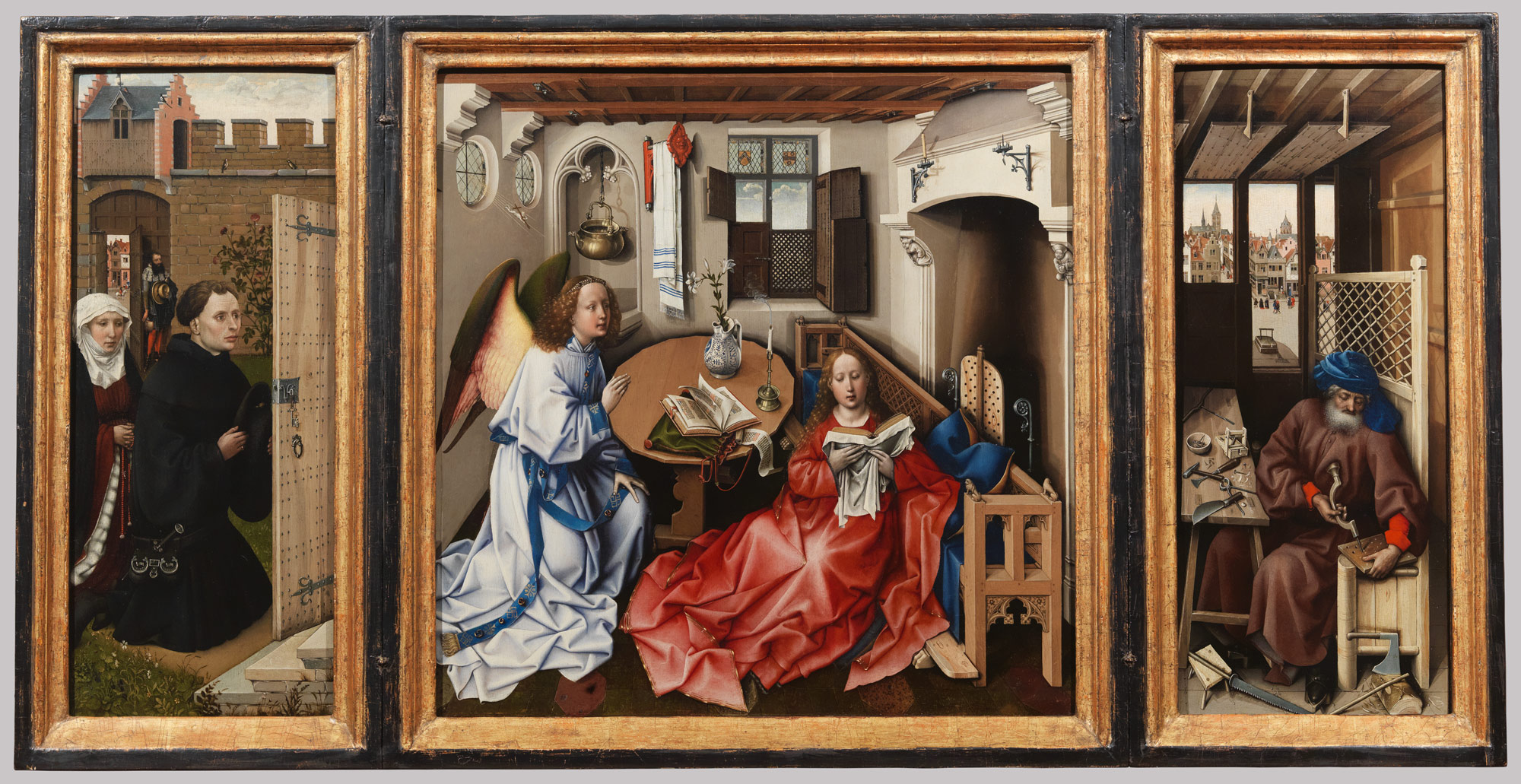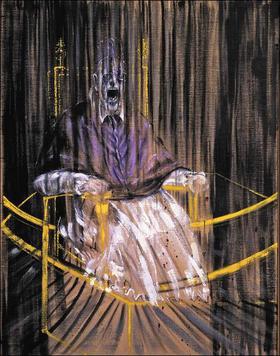The Merode Altarpiece from the Workshop of Robert Campin, The Cloisters,
Metropolitan Museum of Art in NYC
How about an art history lesson? The above piece is the celebrated Merode Altarpiece by Robert Campin (or more accurately, his workshop). Painted in 1427-1432, this rather small but thoroughly captivating masterpiece is my second favorite Annunciation. Robert Campin is one of my favorites of the so called Flemish Primitives, that is painters from the low countries (in and around modern day Belgium) who were active in the 15th and 16th centuries.
Let's start with the subject. Paintings were commissioned and the only folks who could do that were wealthy patrons (individuals) or institutions. Consequently, many of the paintings depict religious scenes or were portraits. This altarpiece was commissioned by the two wealthy individuals on the left side panel called "donors." Donors would commission works of art as a way to increase their chances of getting into heaven. No lie. Hmm. Makes me think of Martin Luther and his objections to indulgences.
 |
| Right Panel - Joseph |
The panel on the far right is very, very cool. That's Joseph and he, being the carpenter, is building a mousetrap. The mousetrap symbolizes how Christ will "trap" and defeat Satan. This kind of symbolism isn't used very much and we are very lucky that Campin chose to include it.
These types of religious paintings are packed with other symbolism which I'm not knowledgable enough to write about but most everything depicted in the painting usually has some kind of meaning or reference.
When I was in NYC last time, I was by myself and determined to see many of the things I missed on previous visits. One of them was going to The Cloisters, a branch of the Met, which is located at the north tip of Manhattan in Fort Tryon Park to see their splendid collection of Medieval art. I was really looking forward to seeing this painting in person and doing some sketching.
When I saw the painting for the first time I was struck by how small it is. Barely four feet across and only 2 feet high. The second thing is all the marvelous details in the painting. Flemish Primitives are known for their almost microscopic details and this lovely domestic scene is packed full of them. I was also struck by how fresh the painting the looks. The paint still looks like it's wet! Shimmering, luminous colors with layers of depth. The photos don't do it justice.
After staring at it for a while, I pulled out my sketchbook and began to draw. I was intimidated as hell about drawing anything from this incredible piece but had settled on her hands. I'd never drawn hands before but I was determined to do it anyway. Sometimes great art inspires you to try crazy things. You can see my efforts below.
When I saw the painting for the first time I was struck by how small it is. Barely four feet across and only 2 feet high. The second thing is all the marvelous details in the painting. Flemish Primitives are known for their almost microscopic details and this lovely domestic scene is packed full of them. I was also struck by how fresh the painting the looks. The paint still looks like it's wet! Shimmering, luminous colors with layers of depth. The photos don't do it justice.
After staring at it for a while, I pulled out my sketchbook and began to draw. I was intimidated as hell about drawing anything from this incredible piece but had settled on her hands. I'd never drawn hands before but I was determined to do it anyway. Sometimes great art inspires you to try crazy things. You can see my efforts below.
A screen shot of the original so you can see what I was aiming for.
Drawing The Virgin's hands was not easy. See that small but exuberant note on the bottom left of my sketchbook page where I mention how happy I am? I was so excited to be seeing this piece of art and I was excited that my sketch actually looked okay. I mean, it's not anything close to the original but it kind of looks like it.
The other thing I was learning to sketch during this trip was folds of fabric. It took a while to get comfortable with drawing heavy drapery but I enjoy such drawings now and sometimes fall back on drawing folds of fabric when I've worn myself out at the end of a museum/sketch visit.
Sketching parts of paintings has been really instructive. When you try to copy a masterpiece you learn so much about the artist and yourself. You have to really look at it and you learn about line, shading, and color. You can sometimes spot small details that aren't immediately apparent such as this one:
See her eyes? You can see how they've shifted ever so slightly because Gabriel has just landed in the room. This is the moment of transition which symbolizes the shift that's coming. In her life, in the world, and in most religious lives. A monumental moment captured so subtly by this master.
I spent a long time staring at this altarpiece and pondering what it would be like to be able to see it all the time. Must be amazing. As it is, I have my sketch to remind me, and now this blog post.
The other thing I was learning to sketch during this trip was folds of fabric. It took a while to get comfortable with drawing heavy drapery but I enjoy such drawings now and sometimes fall back on drawing folds of fabric when I've worn myself out at the end of a museum/sketch visit.
Sketching parts of paintings has been really instructive. When you try to copy a masterpiece you learn so much about the artist and yourself. You have to really look at it and you learn about line, shading, and color. You can sometimes spot small details that aren't immediately apparent such as this one:
See her eyes? You can see how they've shifted ever so slightly because Gabriel has just landed in the room. This is the moment of transition which symbolizes the shift that's coming. In her life, in the world, and in most religious lives. A monumental moment captured so subtly by this master.
I spent a long time staring at this altarpiece and pondering what it would be like to be able to see it all the time. Must be amazing. As it is, I have my sketch to remind me, and now this blog post.























